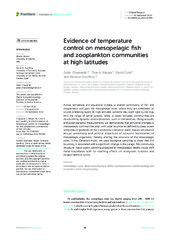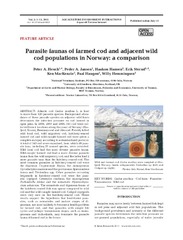Artikler, rapporter og annet (arktisk og marin biologi): Nye registreringer
Viser treff 421-440 av 1643
-
Evidence of temperature control on mesopelagic fish and zooplankton communities at high latitudes
(Journal article; Tidsskriftartikkel; Peer reviewed, 2022-09-06)Across temperate and equatorial oceans, a diverse community of fish and zooplankton occupies the mesopelagic zone, where they are detectable as sound-scattering layers. At high latitudes, extreme day-night light cycles may limit the range of some species, while at lower latitudes communities are structured by dynamic ocean processes, such as temperature. Using acoustic and oceanographic ... -
Parasitic plant small RNA analyses unveil parasite- specific signatures of microRNA retention, loss, and gain
(Journal article; Tidsskriftartikkel; Peer reviewed, 2022-07-21)Parasitism is a successful life strategy that has evolved independently in several families of vascular plants. The genera Cuscuta and Orobanche represent examples of the two profoundly different groups of parasites: one parasitizing host shoots and the other infecting host roots. In this study, we sequenced and described the overall repertoire of small RNAs from Cuscuta campestris and Orobanche ... -
Genetic stock identification reveals greater use of an oceanic feeding ground around the Faroe Islands by multi-sea winter Atlantic salmon, with variation in use across reporting groups
(Journal article; Tidsskriftartikkel; Peer reviewed, 2022-10-18)While it is known that the oceans around the Faroe Islands support an Atlantic salmon (Salmo salar) feeding ground, the relative use of this resource by different age classes and populations remains largely unexplored. Using genetic stock identification and run–reconstruction modelling, we observed a consistent pattern whereby the proportion of multi-sea winter salmon (MSW—fish that have spent ... -
Parasite faunas of farmed cod and adjacent wild cod populations in Norway: a comparison
(Journal article; Tidsskriftartikkel; Peer reviewed, 2011-07-14)Atlantic cod Gadus morhua L. is host to more than 120 parasite species. Background abundance of these parasite species on adjacent wild hosts determines the infection pressure on cod farmed in open pens. In 2006, 2007 and 2008, 343 cod were collected from 4 locations along the coast of Norway: Øksfjord, Kvarøy, Brønnøysund and Ålesund. Freshly killed wild local cod, wild migratory cod, hatchery-reared ... -
The complete mitochondrial genome of the southern calanoid copepod Calanus simillimus Giesbrecht, 1902
(Journal article; Tidsskriftartikkel; Peer reviewed, 2022-07-07)The complete mitochondrial genome of Calanus simillimus is 27,876 bp in length (GenBank accession OK500294) and containing 13 protein-coding genes (PCGs), 2 rRNA genes, 22 transfer RNA genes. The gene order is novel compared to other Calanus species and copepods with sequenced mitogenomes. Phylogenetic analysis suggests that C. simillimus represent a fourth group within Calanus genus in addition ... -
Consequences of COVID-19 on the Reindeer Husbandry in Norway: a Pilot Study Among Management Staff and Herders
(Journal article; Tidsskriftartikkel; Peer reviewed, 2022-05-02)The outbreak of COVID-19 has had an enormous impact on most of society. The most effective measure to prevent the spread has been reducing mobility, which is especially problematic for pastoralists relying on mobility to follow the movement of their livestock. We investigated to what degree Norwegian reindeer husbandry and the reindeer husbandry management system are affected by COVID-19 and government ... -
Native Chilean Fruits and the Effects of Their Functional Compounds on Human Health
(Chapter; Bokkapittel, 2017-03-01)In recent years, there has been great interest in the nutraceutical compounds of fruits from native Chilean plant species. In this context, fruits of Amomyrtus meli (Meli), Aristotelia chilensis (Maqui), Berberis microphylla (Calafate), Luma apiculata (Arrayán), Luma chequén (Chequén), and Ugni molinae (Murtilla) growing predominantly in Chilean forests have been studied. This chapter has compiled ... -
Surface chlorophyll anomalies induced by mesoscale eddy- wind interactions in the northern Norwegian Sea
(Journal article; Tidsskriftartikkel; Peer reviewed, 2022-09-29)The substantial productivity of the northern Norwegian Sea is closely related to its strong mesoscale eddy activity, but how eddies affect phytoplankton biomass levels in the upper ocean through horizontal and vertical transportmixing has not been well quantified. To assess mesoscale eddy induced ocean surface chlorophyll-a concentration (CHL) anomalies and modulation of eddywind interactions in ... -
Spatio-Temporal Variability of Suspended Particulate Matter in a High-Arctic Estuary (Adventfjorden, Svalbard) Using Sentinel-2 Time-Series
(Journal article; Tidsskriftartikkel; Peer reviewed, 2022-06-29)Arctic coasts, which feature land-ocean transport of freshwater, sediments, and other terrestrial material, are impacted by climate change, including increased temperatures, melting glaciers, changes in precipitation and runoff. These trends are assumed to affect productivity in fjordic estuaries. However, the spatial extent and temporal variation of the freshwater-driven darkening of fjords remain ... -
Impact of the COVID-19 pandemic on human-nature relations in a remote nature-based tourism destination
(Journal article; Tidsskriftartikkel; Peer reviewed, 2022-09-29)Tourism and nature-based recreation has changed dramatically during the COVID-19 pandemic. Travel restrictions caused sharp declines in visitation numbers, particularly in remote areas, such as northern Norway. In addition, the pandemic may have altered human-nature relationships by changing visitor behaviour and preferences. We studied visitor numbers and behaviour in northern Norway, based on ... -
Impact of climatic change on alpine ecosystems: inference and prediction
(Journal article; Tidsskriftartikkel; Peer reviewed, 2011-01-26)Alpine ecosystems will be greatly impacted by climatic change, but other factors, such as land use and invasive species, are likely to play an important role too. Climate can influence ecosystems at several levels. We describe some of them, stressing methodological approaches and available data. Climate can modify species phenology, such as flowering date of plants and hatching date in insects. It ... -
Life history adaptations to fluctuating environments: Combined effects of demographic buffering and lability
(Journal article; Tidsskriftartikkel; Peer reviewed, 2022-08-20)Demographic buffering and lability have been identified as adaptive strategies to optimise fitness in a fluctuating environment. These are not mutually exclusive, however, we lack efficient methods to measure their relative importance for a given life history. Here, we decompose the stochastic growth rate (fitness) into components arising from nonlinear responses and variance–covariance of demographic ... -
Spatial occurrence and abundance of marine zooplankton in Northeast Greenland
(Journal article; Tidsskriftartikkel; Peer reviewed, 2022-08-20)We present a large-scale survey of mesozooplankton (size range 0.2–20 mm) across coastal, shelf, and slope locations in Northeast Greenland (latitudes 74–79° N, August 2015 and September 2017). Our study is centred on the Video Plankton Recorder (VPR) for non-invasive in situ observations of taxa distribution and abundance while simultaneously recording oceanographic profiles. A modified WP-2 plankton ... -
Importance of bacteria and protozooplankton for faecal pellet degradation
(Journal article; Tidsskriftartikkel; Peer reviewed, 2014)The degradation mechanisms of faecal pellets are still poorly understood, although they determine their contribution to vertical fluxes of carbon. The aim of this study was to attempt to understand the microbial (bacteria and protozooplankton) degradation of faecal pellets by measuring the faecal pellet carbon-specific degradation rate (FP-CSD) as an indicator of pellet degradation. ‘In situ’ and ... -
Marine mammal consumption and fisheries removals in the Nordic and Barents Seas
(Journal article; Tidsskriftartikkel; Peer reviewed, 2022-05-28)In this study, we assess prey consumption by the marine mammal community in the northeast Atlantic [including 21 taxa, across three regions: (I) the Icelandic shelf, Denmark Strait, and Iceland Sea (ICE); (II) the Greenland and Norwegian Seas (GN); and (III) the Barents Sea (BS)], and compare mammal requirements with removals by fisheries. To determine prey needs, estimates of energetic requirements ... -
Chemosynthetic and photosynthetic trophic support from cold seeps in Arctic benthic communities
(Journal article; Tidsskriftartikkel; Peer reviewed, 2022-08-17)Benthic communities below the photic zone are largely reliant on the export of surface-water primary production and the flux of partially degraded organic matter to the seabed, i.e. pelagic−benthic coupling. Over the past decades, however, the role of chemosynthetically produced carbon in food webs has been recognized in various habitats. Cold seeps are now known to be widespread across circumpolar ... -
Horizontal and Vertical Migration of Anglerfish Lophius piscatorius in Relation to Hydrography in Faroese Waters
(Journal article; Tidsskriftartikkel; Peer reviewed, 2022-03-04)Adult anglerfish conduct annual migrations between spawning areas and feeding areas; for Faroese waters this migration has so far not been described. Therefore, anglerfish migration and distribution in Faroese waters was investigated by mark-recapture studies, including data storage tags, as well as data from scientific trawl surveys, commercial trawlers and gillnetters. The fish distribution was ... -
Mixed interactions among life history stages of two harvested related species
(Journal article; Tidsskriftartikkel; Peer reviewed, 2022-03-07)Climate change and harvesting can affect the ecosystems' functioning by altering the population dynamics and interactions among species. Knowing how species interact is essential for better understanding potentially unintended consequences of harvest on multiple species in ecosystems. I analyzed how stage-specific interactions between two harvested competitors, the haddock (Melanogrammus aeglefinus) ... -
A review of the scientific knowledge of the seascape off Dronning Maud Land, Antarctica
(Journal article; Tidsskriftartikkel; Peer reviewed, 2022-08-29)Despite the exclusion of the Southern Ocean from assessments of progress towards achieving the Convention on Biological Diversity (CBD) Strategic Plan, the Commission for the Conservation of Antarctic Marine Living Resources (CCAMLR) has taken on the mantle of progressing eforts to achieve it. Within the CBD, Aichi Target 11 represents an agreed commitment to protect 10% of the global coastal and ... -
Flavonoid biosynthesis is differentially altered in detached and attached ripening bilberries in response to spectral light quality
(Journal article; Tidsskriftartikkel; Peer reviewed, 2022-07-22)Light spectral quality is known to affect flavonoid biosynthesis during fruit ripening. However, the response of fruits to different light conditions, when ripening autonomously from the parent plant (detached), has been less explored. In this study, we analyzed the effect of light quality on detached and naturally ripening (attached) non-climacteric wild bilberry (Vaccinium myrtillus L.) fruits ...


 English
English norsk
norsk


















